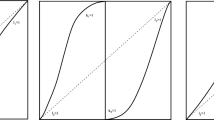Abstract
Recent work by Robert Batterman and Alexander Rueger has brought attention to cases in physics in which governing laws at the base level “break down” and singular limit relations obtain between base- and upper-level theories. As a result, they claim, these are cases with emergent upper-level properties. This paper contends that this inference—from singular limits to explanatory failure, novelty or irreducibility, and then to emergence—is mistaken. The van der Pol nonlinear oscillator is used to show that there can be a full explanation of upper-level properties entirely in base-level terms even when singular limits are present. Whether upper-level properties are emergent depends not on the presence of a singular limit but rather on details of the ampliative approximation methods used. The paper suggests that focusing on explanatory deficiency at the base level is key to understanding emergence in physics.
Similar content being viewed by others
References
Batterman R. W. (1997) Into a mist: Asymptotic theories on a caustic. Studies in History and Philosophy of Modern Physics 28B(3): 395–413
Batterman R. W. (2002a) Asymptotics and the role of minimal models. British Journal for the Philosophy of Science 53(1): 21–38
Batterman R. W. (2002b) The Devil in the details: Asymptotic reasoning in explanation, reduction, and emergence. Oxford University Press, Oxford, New York
Batterman R. W. (2005a) Critical phenomena and breaking drops: Infinite idealizations in physics. Studies in History and Philosophy of Modern Physics 36B(2): 225–244
Batterman R. W. (2005b) Response to Belot’s “Whose devil? Which details?”. Philosophy of Science 72(1): 154–163
Batterman R. W. (2009) Idealization and modeling. Synthese 169: 427–446
Bedau M. A. (1997) Weak emergence. In: Tomberlin J. (eds) Philosophical perspectives: Mind, Causation and world. Blackwell, Malden, pp 375–399
Bedau M. A. (2008) Is weak emergence just in the mind?. Minds and Machines: Journal for Artificial Intelligence, Philosophy, and Cognitive Science 18(4): 443–459
Belot G. (2005) Whose devil? Which details?. Philosophy of Science 72(1): 128–153
Broad C. D. (1925) The mind and its place in nature. Routledge & K. Paul, London
Humphreys P. (1997) How properties emerge. Philosophy of Science 64: 1–17
Humphreys P. (2008) Computational and conceptual emergence. Philosophy of Science 75(5): 584–594
Kim J. (1999) Making sense of emergence. Philosophical Studies 95: 3–36
Kim J. (2005) Physicalism, or something near enough. Princeton University Press, Princeton
Kim J. (2006) Emergence: Core ideas and issues. Synthese 151(3): 547–559
McGivern, P. (2007). Comments on Andrew Wayne’s ‘Singular limits, explanation and emergence in physics’. Pacific APA meeting.
Nagel E. (1961) The structure of science: Problems in the logic of scientific explanation. Harcourt, Brace World, New York
Nickles T. (1973) Two concepts of inter-theoretic reduction. Journal of Philosophy 70(7): 181–201
Redhead M. (2004) Asymptotic reasoning. Studies in History and Philosophy of Modern Physics 35B(3): 527–530
Rueger A. (2000a) Physical emergence, diachronic and synchronic. Synthese 124: 297–322
Rueger A. (2000b) Robust supervenience and emergence. Philosophy of Science 67: 466–489
Rueger A. (2001) Explanations at multiple levels. Minds and Machines: Journal for Artificial Intelligence 11(4): 503–520
Rueger A. (2004) Reduction, autonomy, and causal exclusion among physical properties. Synthese 139(1): 1–21
Rueger A. (2006) Functional reduction and emergence in the physical sciences. Synthese 151(3): 335–346
Schaffner K. F. (1976) Reduction in biology: Prospects and problems. Boston Studies in the Philosophy of Science 32: 613–632
Schaffner K. F. (2008) Theories, models, and equations in biology: The heuristic search for emergent simplifications in neurobiology. Philosophy of Science 75(5): 1008–1021
van der Pol B., van der Mark J. (1928) The heartbeat considered as a relaxation oscillation, and an electrical model of the heart. Philosophical Magazine 6: 763–775
Wayne, A. (2010). Expanding the scope of explanatory idealization. Philosophy of Science (forthcoming).
Wayne A., Arciszewski M. (2009) Emergence in physics. Philosophy Compass 4(1): 1–13
Author information
Authors and Affiliations
Corresponding author
Rights and permissions
About this article
Cite this article
Wayne, A. Emergence and singular limits. Synthese 184, 341–356 (2012). https://doi.org/10.1007/s11229-010-9817-0
Received:
Accepted:
Published:
Issue Date:
DOI: https://doi.org/10.1007/s11229-010-9817-0




